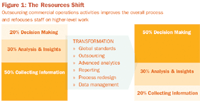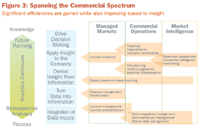Knowledge-Based Outsourcing: Driving Deeper Insights
Tracking, monitoring, and trend evaluation is not enough. Companies must now do more than assess what happened and why.
Outsourcing the management of clinical trials, manufacturing, and packaging, as well as (to a limited extent) data management and sales operations, is fairly commonplace in the world of pharma. However, companies are showing themselves to be even more adventurous in trying on for size the outsourcing of analytic functions.

GETTY IMAGES / DIETER SPANNKNEBEL
Ideally, outsourcing enables organizations to improve operational effectiveness and gain improved insights, freeing resources to focus on decision making (see Figure 1). The conventional wisdom is that these efficiencies can in turn put companies on the fast track to greater insight—an "aha!" moment, if you will—that can propel them toward greater commercial success.

Figure 1: The Resources Shift
Weighing the Options
To date, knowledge-based outsourcing has been limited to a reliance on partners for incentive compensation, sales reporting, and some data management. While the amount of spending has been significant, it is concentrated on single processes and individual needs.
Many companies in the industry are in an assessment phase to determine which activities and processes they should hold on to from a strategic standpoint versus those that might benefit from outsourcing. Advice and frameworks in the area abound, and making the wrong decision can be detrimental, especially as the industry moves from piecemeal initiatives to large-scale outsourcing efforts (see Figure 2).

Figure 2: The Value Chain-Outsourcing Information-Intensive Processes
At best, knowledge-based outsourcing can drive commercial excellence and cost efficiencies within and across commercial support functions by offering:
» More effective and adaptable decision support for sales, marketing, and managed markets operations;
» Improved processes, stemming from wider exposure to methodologies that lead to the adoption of best practices in sales force effectiveness, sales and marketing analytics, multichannel marketing, and information management, for example;
» Higher-quality data interpretation, owing to a broader perspective;
» Greater staffing flexibility and access to critical expertise through peaks of demand (during launches, for instance) plus variability in cost structures as the need wanes. IT functions have benefited from utility computing—the notion that capacity is scalable and available on demand—and the same approach can work for knowledge-based activities;
» Lower operational costs (tracked as being reduced by as much as 20 percent to 30 percent);
» Global consistency and standardization;
» Adherence to changing regulatory, privacy, and security requirements; and lastly
» Freedom from the costs associated with training and retaining knowledge experts.
Realizing the Advantage
Creating variable capacity via outsourcing can be complex when the functions under consideration are decentralized within the company. If a centralized operation is to be outsourced, typically fewer stakeholders are involved, and the process is less arduous. Successful transitions typically focus on:
» Identifying cost reduction opportunities that don't compromise the integrity of existing programs;
» Streamlining workflows and improving processes—within a specific country, across a region, or around the world;
» Establishing analytical teams that are centralized, offshore/external, and scalable;
» Enabling a common platform for research findings and recommendations; and
» Focusing a smaller number of internal resources, each with unique talent or knowledge, on higher-value activities that leverage analytical output.
However, if a company's processes or functions are decentralized, there is an even greater opportunity to drive speed to insight as analytical and information processes can be streamlined in a manner that eliminates commonly redundant activities through:
» Improved data integration and management;
» Best practice analytic approaches and methodologies;
» Consistency in Key Performance Indicators (KPIs) and metrics to measure success; and
» Leveraging a common knowledge repository.
The migration towards outsourcing starts with an informed diagnostic assessment of the decision-making process and the supporting information processes. After one clearly defines the processes, a model can be developed to flexibly and effectively support the dynamic needs of the business.
Additional Scope
Outsourcing is not just about cost cutting via offshoring; it is about extending the organization's business edge while gaining resource efficiency and operational capacity. In doing so, companies may seek solutions for:
» Commercial Operations–data integration, performance analytics and reporting, data management, incentive compensation, call planning, segmentation, customer relationship management (CRM), and sales administration;
» Market Intelligence–analytics and reporting, brand insights, competitive intelligence, opportunity assessment, and forecasting; and
» Managed Markets Analytics–contract management and administration, and government and market pricing, access, and rebate analysis/adjudication/reconciliation (see sidebar).

One Key Application: Analytics in Managed Markets
Such solutions span the commercial spectrum and drive companies toward efficiencies to be gained along an "analytics continuum" from retrospective analyses to future planning (see Figure 3). While the sales and marketing operations each require different types of data, at a high level they should follow similar processes, including integrating data and creating market definitions. Improving speed to insight is essential in order to better target customers and ensure better interactions with them.

Figure 3: Spanning the Commercial Spectrum
In its broadest sense, analytics covers both business intelligence and more sophisticated predictive modeling and scenario-based "guided analytics" (promotion response, segmentation, targeting). Such work helps a company focus on customer insights and track market trends to better gauge and predict the business impact of decisions. Both areas can be outsourced; however, the evolution toward guided analytics can evolve much faster than many believe because a greater competitive advantage can be gained by leveraging best practices, reducing information complexity, and applying more advanced analytic capabilities. Outsourcing-guided analytics involves working with a partner that has sufficient domain expertise to free in-house staff to perform analyses, interpret findings, and prepare recommendations—the higher-level work that they both want and need to be doing.
Changing market dynamics and an evolving customer base have underscored the need to move beyond merely tracking, monitoring, and trending toward predictive modeling and forecasting. Increasingly, companies must do more than assess what happened and why; they must perform actionable analytics and make information-intensive processes more efficient.
Delivering Value
The two fundamental objectives of knowledge-based outsourcing are: 1) To introduce variable cost models to support fluctuating capacity requirements; and 2) To add strategic value and perspective to the organization. In less than ideal situations, these objectives compete with one another. However, when the partner understands the industry, the stakeholders, commercial functions, data sources, and the type of insight required to make business decisions, the two objectives can be met without conflict.
The transition to outsourcing relationships will involve some level of disruption around the processes being streamlined. What may initially seem like loss of control can mask pathways to more intellectual leverage of internal resources. Another potential issue is the training required by partners who lack the necessary domain expertise (when, in some situations, those employees who would have been the ideal mentors are now gone). Underestimating the amount of oversight and project management required for the transition could lead to disappointing results.
Four Markers of Success
To effectively deliver value to the organization through knowledge-based outsourcing:
1. Work with your internal stakeholders to create a strategic plan and associated roadmap, ensuring that what you envision will fit their needs.
2. Determine which internal support structure and outsourcing approach will best serve the company depending on the diversity of its portfolio, the number and size of products in each therapy area, the stage of products in their lifecycle, and the company's growth prospects. (A "Vertical Brand Model" aligns resources to high-potential brands; a "Shared Services Model" pools the resources for users across commercial operations, business intelligence, and managed markets to tap into various services as needed. A hybrid approach combines features of each.)
3. Engage partners that know the industry and can deliver value through domain expertise while also offering scalability and the means to drive larger cost savings.
4. Employ risk management strategies around the transition, and share success and learning across the organization.
Commercial operations in the future must position themselves as quality, high-performance teams that service stakeholders with a high return on their investment. This can only be achieved via a well thought out overall strategy that includes outsourcing in a way that is more than a budget-trimming exercise.
With the right outsourcing model and the right outsourcing partner—one who is intimately familiar with the workings and needs of the industry—pharmaceutical companies can enjoy the benefits of cost variability, realize efficiencies in their information-intensive processes, and arrive at insights faster. And it all, of course, is a means to another end: agility and innovation that will help companies re-establish a positive growth trajectory and sustain long-term profitability.
Tim Kelly is Vice President, Offerings and Development, IMS Consulting and Services. He can be reached at tkelly@us.imshealth.com. Chris Nickum is Vice President and Global Practice Leader, Commercial Effectiveness, IMS Consulting and Services. He can be reached at cnickum@us.imshealth.com

The Misinformation Maze: Navigating Public Health in the Digital Age
March 11th 2025Jennifer Butler, chief commercial officer of Pleio, discusses misinformation's threat to public health, where patients are turning for trustworthy health information, the industry's pivot to peer-to-patient strategies to educate patients, and more.
Talphera Cuts NEPHRO CRRT Study Size, Secures $14.8 Million Private Placement
April 1st 2025The trial size adjustment, along with protocol modifications and the addition of higher-enrollment sites, is expected to facilitate completion of the NEPHRO CRRT study of Niyad in patients undergoing renal replacement therapy by the end of 2025.
Navigating Distrust: Pharma in the Age of Social Media
February 18th 2025Ian Baer, Founder and CEO of Sooth, discusses how the growing distrust in social media will impact industry marketing strategies and the relationships between pharmaceutical companies and the patients they aim to serve. He also explains dark social, how to combat misinformation, closing the trust gap, and more.